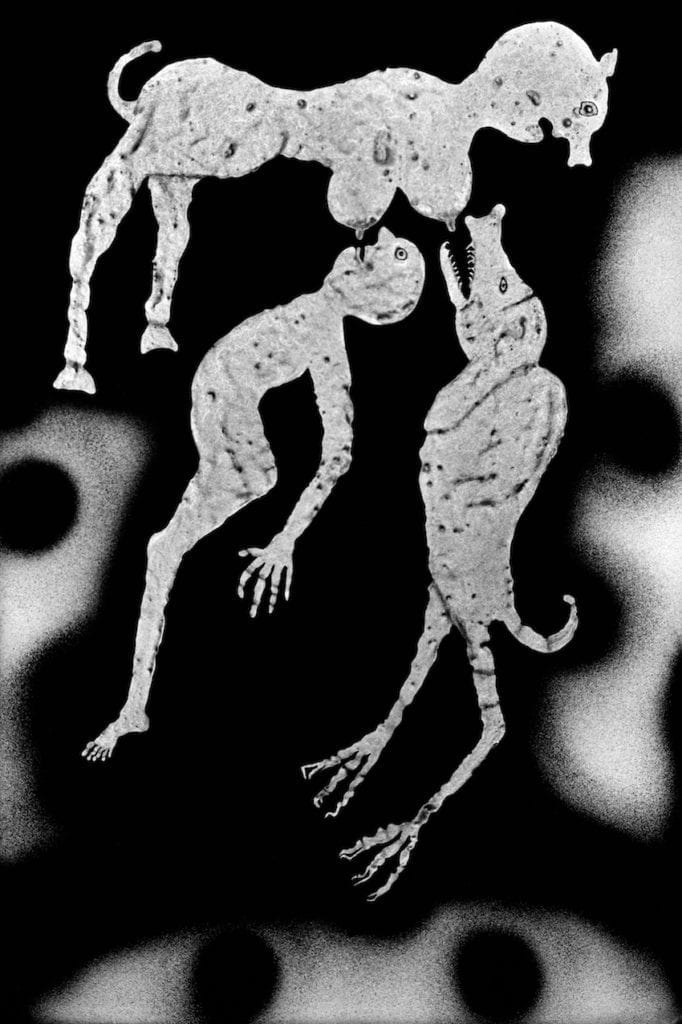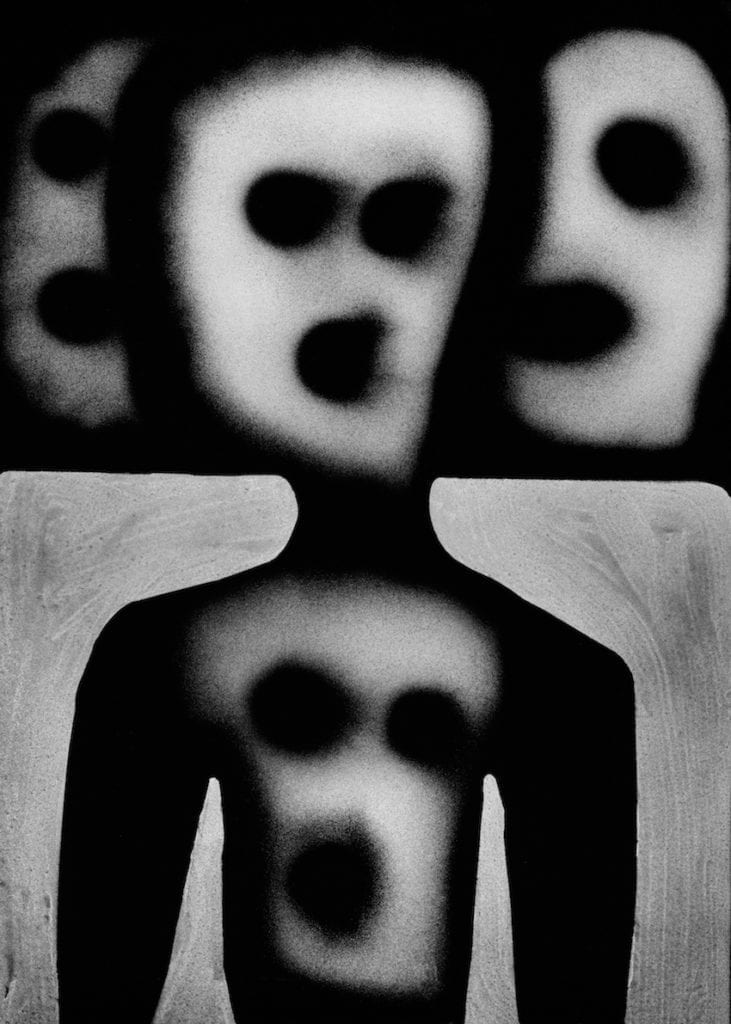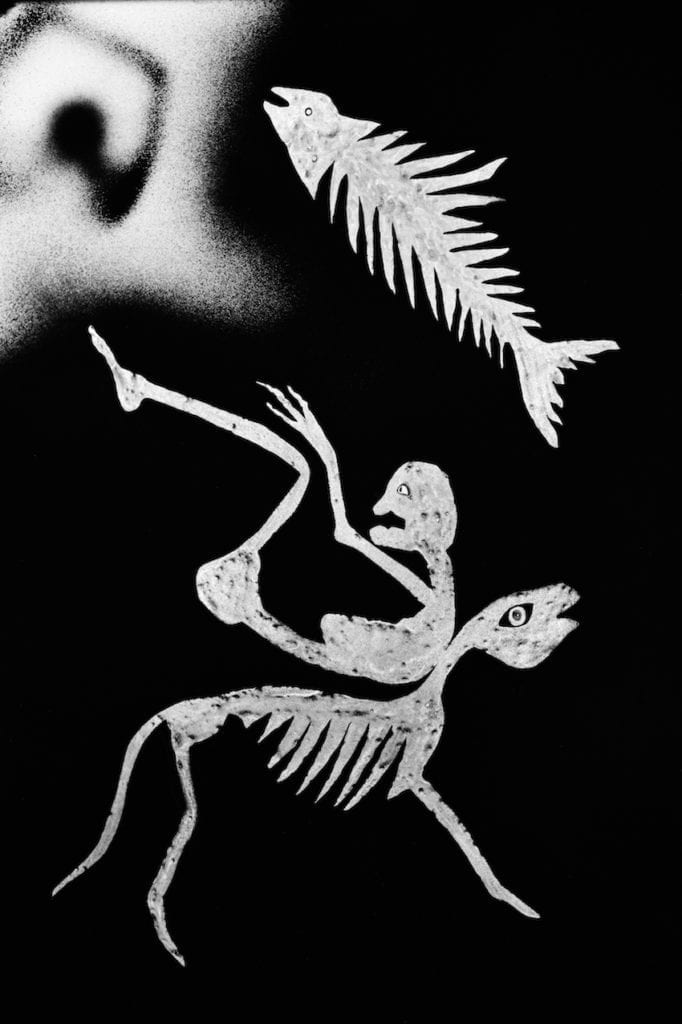The photographer of the psyche, Roger Ballen, is in London to show his latest work, The Theatre of Apparitions, the first time he’s exhibited the series. Based in South Africa since the early 1980’s, the New York-born photographer has worked in photography for over thirty years, starting with ‘straight’ documentary but latterly moving into more abstract forms representing the relationship between human and beast, and harking back to the ancient shamanistic visions and symbols which he believes are embedded in us all.
The Theatre of Apparitions is inspired by hand-drawn carvings he saw on blacked-out windows in a women’s prison in South Africa. “The images occupy a perceptual realm – a fragmented world of part – objects where fears of annihilation and chaotic perceptions merge reality and fantasy, self and other,” says Ballen. “These silhouettes are flickering archetypes originating from the collective unconscious of human kind.”

BJP: This work is quite different to what you have done before, what inspired it?
RB: At the beginning of 2005, I was making a video in a women’s prison in South Africa, in Johannesburg. I went into one of the cells, and I saw that somebody had made some drawings on some window – these drawings were very luminous and I took pictures of them that ended up in my Shadow Chambers book, published in 2005. This was very different from anything I photographed before. Thereafter, I started working in some abandoned buildings that had a lot of windows, so I started making drawings on the windows and taking pictures of them.
It turned out to be very interesting, very different from what I had done [previously]. I was quite inspired, and keen to continue. It was like a snowball – I started to develop new techniques and it was almost magical what came out of this glass, using paint, markers or whatever. I initially shot with a Rolleiflex 6×6 film camera and then, later on, when I moved to another space with more rectangular windows, I started to use a Mamiya 5×6. The project started in 2005 and lasted until 2013.
BJP: How did your career evolve from documentary photography to more abstract work?
RB: My life in photography has always been a psychological and personal journey. Roger Ballen is changing all the time. It’s not necessarily documenting what is out there, but it’s what concerns me psychologically….One has to adopt what one needs. For instance, some people need to find the worst in different places of the world; people like myself are more interested in photography as a personal psychological journey through time. This has always been the purpose, although my work in the 1960s, 70s and 80s was more documentary.
Furthermore, I was younger and I wouldn’t have been able to do pictures like these. I didn’t have the skills, psychological capability or techniques to do what I do now. Through years my work becomes more complex, concise and clear. I’ve been doing photography for fifty years now and it keeps evolving, the development of my styles through time can be seen in a book coming out in September called Ballenesque.

BJP: I have the impression your work is strongly focused on feelings and desires which are repressed by society, is that correct?
RB: It’s not so much about society but more about how the mind represses itself. Specifically, I’m talking about repressing your own instincts, your own urges, repressing part of yourself which has something to do with culture, upbringing, your personality, your experiences. Our personalities have evolved over thousands years, during which we had to repress our instincts to fit into society. We all do repress something, I guess for the benefit of survival. But nowadays people are going too far – they don’t follow themselves, they don’t follow their instincts, they cut them off. Instead, they follow leaders and political movements, they follow consumer movements.
This is not necessarily a product of the Western world. If you look at some very traditional societies you can find more repression than there is in the Western societies. This is a worldwide problem – I’ve always said that until humanity, and until the majority of individuals in the world, come into contact with the deeper part of themselves and relink some of the repressions they are living with, there is no chance of any optimism on the planet. People are blaming others for their problems, they are angry at the world, they are angry at themselves, they are angry about their limitations. So it’s a constant circular problem that exists and as long as this continues there is no hope, peace, tranquillity or stabilisation.
BJP: Why do you think people don’t come to terms with themselves?
RB: They can not deal with themselves. The fundamental instinct of life is death. They cannot come to terms with their own death, with their own limitations, with their own insecurity. With my photographs, I try to delve deeper into the nature of the human mind. My pictures are about penetrating the subconscious mind, revealing aspects of the subconscious mind to myself and to the viewer, hopefully helping other people, as well as myself, to come to terms with the divided self.
BJP: Don’t you think that we should control our subconscious?
RB: Your subconscious may control you. It’s easy to use these terminologies, but where is the subconscious mind? There are many layers and levels, it’s not so simplistic. Maybe my subconscious mind it’s talking to you now. You cannot say this side is conscious and this is unconscious, it’s all coming from the same brain. Sometimes people say that my pictures are dark and disturbing, probably because they haven’t come to terms with themselves. My pictures are trying to delve into deeper personality.
Roger Ballen’s Theatre of Apparitions is on show at Hamiltons Gallery, London, until 21st of April 2017. www.hamiltonsgallery.com A video of The Theatre of Apparitions, made with the collaboration of Marguerite Rossouw, Emma Calder, Ged Haney and the composer John Webb, can be viewed via YouTube


